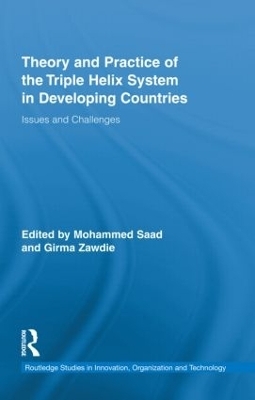
Theory and Practice of the Triple Helix Model in Developing Countries
Routledge (Verlag)
978-0-415-47516-7 (ISBN)
Theory and Practice of Triple Helix Model in Developing Countries contributes to the expanding literature on "triple helix" innovation - focusing on developing countries. The book is based on practical cases and experiences from Africa, Latin America and Asia. Relevant experiences and best practices from developed countries are also examined.
The book is presented as a response to the growing awareness about the need for policy shift from the traditional technology transfer practice to a policy position that is capable of providing a sustainable basis for innovation and technological progress in developing countries. The book explores the triple helix system of innovation based on the dynamics of the interactive relationships between government, industry and universities in the creation, dissemination and sharing of knowledge in developing countries. A major point addressed by the book is the extent to which the ‘triple helix’ system of relationships between university, industry and government can enhance the effectiveness of universities in developing countries as agents of innovation, industrialization and sustainable development.
Mohammed Saad is a Professor of Innovation and Technology Management at the Bristol Business School. His teaching, consultancy and research activities include mainstream operations management, innovation and technology management. Girma Zawdie is a Lecturer in economics and sustainable development in the David Livingstone Centre for Sustainability, at the University of Strathclyde. Areas of his research focus include technology management and policy issues relating to the environment, world poverty and sustainable development.
Introduction. M. Saad and G. Zawdie Section I: Knowledge Production, Sharing and Use Through Triple Helix 1. Triple Helix Knowledge Clusters: Accelerating Innovation and Creating Transformative Networks. L. W. Jerome 2. Innovation Systems Interactions and Technology Transfer and Assimilation for Industrial Development: the Cases of South Korea and Mexico. María Isabel Rivera Vargas 3. A New Regulatory Framework for the Relationship between University and Industry: the Brazilian Experience. Anne-Marie Maculan, and José Manoel Carvalho de Mello 4. Inter-Organizational Learning Through South-South Cooperation: A Case Study Investigation. Najeh Bouraoui, Amira Bouhamed and Jamil Chaabouni 5. Guarding the Gatekeeper: University Research Managers in a Triple Helix Environment. John Kirkland and Julie Stackhouse 6. Re-Visiting Agricultural Science for Development: From Mode 1 to Mode 2. Norman Clark Section II: Operationalising the Triple Helix Model and Bridging the Gaps 7. The Triple Helix Paradigm in Korea and Taiwan: A Test for New Forms of Capital. Matthew Shapiro 8. Mobilizing for Development: Putting the Triple Helix into Action in Ghana. James Dzisah 9. Bridging the Gaps in the Triple Helix: A Case Study Based on the Challenge of the Indonesian Experience. Dessy Irawati 10. The Incubator Movement: A Comparative Analysis of Brazil and Mexico. Mariza Almeida, and Maria Del Pilar Montserrat Perez Hernandez 11. The Challenges Arising in the Evolution of the Triple Helix Institutional System: The Case of Malaysia. Azley Abd Razak and Mohammed Saad 12. Innovation in a Developing Country Context: Developing an Integrated Framework through India’s Experience. Surja Datta and Mohammed Saad 13. Science Parks and University-Industry Collaboration in Malaysia. Girma Zawdie and Chandra Malairaja Section III: Shift towards a Triple Helix Policy Paradigm and Implications for Developing Countries 14. Creative Reconstruction – Towards a Triple Helix Innovation Strategy in Central and Eastern Europe Countries. Marina Ranga and Henry Etzkowitz 15. Not Yet Triple Helix III? Japanese MOT Policies and the Problem of Technology Exploitation. Ingyu Oh
| Erscheint lt. Verlag | 12.5.2011 |
|---|---|
| Reihe/Serie | Routledge Studies in Innovation, Organizations and Technology |
| Zusatzinfo | 38 Tables, black and white; 22 Halftones, black and white; 38 Illustrations, black and white |
| Verlagsort | London |
| Sprache | englisch |
| Maße | 152 x 229 mm |
| Gewicht | 780 g |
| Themenwelt | Mathematik / Informatik ► Mathematik ► Finanz- / Wirtschaftsmathematik |
| Technik ► Umwelttechnik / Biotechnologie | |
| Wirtschaft ► Betriebswirtschaft / Management ► Unternehmensführung / Management | |
| Wirtschaft ► Volkswirtschaftslehre ► Makroökonomie | |
| ISBN-10 | 0-415-47516-3 / 0415475163 |
| ISBN-13 | 978-0-415-47516-7 / 9780415475167 |
| Zustand | Neuware |
| Haben Sie eine Frage zum Produkt? |
aus dem Bereich


